The Science Behind Coffee Developing: How Temperature and Time Affect Your Beverage
Comprehending the science behind coffee brewing discloses that temperature and time are not mere variables yet crucial components that dictate the beverage's flavor account and general top quality. The optimum brewing temperature level normally falls between 195 ° F and 205 ° F, while the duration of removal varies considerably across various methods. This interaction of variables can cause a cup that is either wonderful or disappointing. As we check out the subtleties of these elements, the inquiry occurs: just how can one effectively equilibrium temperature and time to achieve that perfect brew?
The Chemistry of Coffee Extraction
The chemistry of coffee extraction explores the intricate procedures that change raw coffee beans into the aromatic drink appreciated worldwide. This makeover mostly involves the solubility of various substances existing in the beans, which are affected by aspects such as work dimension, water top quality, and the developing technique utilized.
Throughout the brewing procedure, warm water functions as a solvent, removing soluble substances, consisting of caffeine, acids, lipids, and sugars, from the coffee premises. Each substance adds to the flavor account, aroma, and body of the last drink. Acids are responsible for tangy and intense notes, while oils contribute to a rich mouthfeel.
The initial phases of developing essence acids and sugars, leading to an enjoyable level of acidity, while extended removal can lead to anger due to over-extraction of unwanted compounds. Understanding these chemical communications is critical for maximizing brewing methods, as the equilibrium in between extraction time and water temperature can considerably influence the overall quality of the coffee.
Ideal Brewing Temperatures
Discovering the right brewing temperature level is essential for opening the complete capacity of coffee flavors and aromas - coffee brewing methods. Research study shows that the optimal range for developing coffee exists in between 195 ° F to 205 ° F(90 ° C to 96 ° C) Within this array, the removal process effectively liquifies the preferable soluble compounds in coffee beans, resulting in a balanced and delicious cup
Brewing at reduced temperature levels, such as listed below 195 ° F(90 ° C ), may result in under-extraction, producing a weak and acidic brew with low-key tastes. Conversely, brewing at temperature levels going beyond 205 ° F(96 ° C) can result in over-extraction, producing a rough and bitter preference because of the excessive dissolution of unfavorable substances, such as tannins.
Additionally, the excellent brewing temperature level can differ relying on the coffee bean kind and roast level. Lighter roasts frequently profit from somewhat greater temperatures to improve their intricate taste accounts, while darker roasts might be better suited to lower temperature levels to alleviate bitterness.
Inevitably, keeping precision in developing temperature levels is essential for achieving an unified equilibrium of tastes, making sure that every cup of coffee supplies an enjoyable sensory experience.
Impact of Developing Time
Developing time plays a crucial role in figuring out the flavor account and general quality of coffee. The removal process, which influences the taste, fragrance, and body of the beverage, is mainly depending on the length of time the coffee premises are in call with water. Much shorter developing times can result in under-extraction, bring about a sour or weak taste, as not adequate soluble compounds are dissolved. Alternatively, prolonged developing can cause over-extraction, where unwanted substances are released, resulting in an astringent or bitter taste.
Optimal brewing time differs relying on the method made use of and the grind dimension of the coffee. A French press typically requires regarding four mins, while espresso removal is normally completed within 25 to 30 seconds. It is necessary to calibrate developing time in conjunction with various other variables, such as water temperature level and coffee-to-water proportion, to achieve the desired taste account.
Comprehending the impact of brewing time enables coffee lovers to improve their developing methods, eventually boosting the sensory experience of their cup (coffee brewing methods). With mindful focus to this variable, one can unlock the complete potential of the coffee, exposing its unique qualities and subtleties
Developing Techniques and Their Impacts

For example, methods like French press and cool mixture permit a longer steeping time, leading to a fuller body and robust taste because of boosted removal of oils and soluble solids. On the other hand, coffee brewing makes use of high stress and a shorter removal time, generating a concentrated shot that stresses extreme flavors and a rich crema.
Pour-over strategies, such as Chemex or V60, provide an even more controlled removal procedure, permitting the maker to control circulation rate and water distribution, which can boost illumination and clearness. Percolation approaches cycle water with the coffee premises numerous times, leading to a stronger, usually bitter taste.
Last but not least, using paper filters versus steel filters can likewise influence the final preference; paper filters generally generate a cleaner cup by trapping oils and fine particles, while steel filters allow more oils to travel through, adding to a fuller mouthfeel - coffee brewing methods. Recognizing these nuances can elevate the coffee experience significantly
Tips for Refining Your Mixture
A well-executed brew can change site web even the most basic coffee into an exceptional experience. To accomplish this, interest to detail is necessary. Start with top notch, newly roasted beans, as their flavor profile reduces over time. Grind the beans just before making to maximize quality, guaranteeing the grind size matches your brewing technique-- coarser for French press and finer for espresso.
Water high quality plays an important duty; usage filteringed system water devoid of pollutants. The ideal brewing temperature ranges between 195 ° F and 205 ° F(90 ° C to 96 ° C ) As well hot can scorch the coffee, while too amazing may under-extract flavors.
Timing is equally important. For immersion approaches, soaking for three to five minutes is optimum, whereas drip techniques generally take about five mins. Experiment with mixture times to discover your favored strength.

Final Thought
In recap, the elaborate connection in between temperature level and time is critical in the coffee developing advice process. Complying with ideal developing temperature levels between 195 ° F and 205 ° F, together with precise timing tailored to each technique, ensures the desired taste account is achieved. Comprehending these clinical concepts encourages individuals to improve their brewing strategies, ultimately leading to a much more pleasurable and balanced coffee experience. Mastery of these aspects is crucial for any kind of coffee enthusiast seeking quality in their drink.
Understanding the scientific research behind coffee developing reveals that temperature and time are not simple variables yet critical aspects that dictate the beverage's taste account and overall top look at this site quality. Understanding these chemical interactions is vital for enhancing brewing strategies, as the equilibrium in between removal time and water temperature can substantially affect the general quality of the coffee.Brewing time plays an essential role in determining the flavor account and general top quality of coffee. By focusing on these components-- bean high quality, grind dimension, water temperature, steeping time, and proportion-- you can raise your coffee developing process, resulting in a constantly remarkable cup.
In summary, the intricate relationship in between temperature level and time is critical in the coffee brewing process.